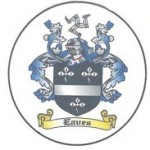There are over 3 billion markers in a human genome. The markers used to determine paternal lineage found in the yDNA sex chromosome, are those letters or numbers across the top of the chart which are the “names” of those particular markers.
In the diagram of the double helix, the rungs of the ladder hold the key to the number of those markers. The composition of that ladder is a sugar phosphate that supports the rungs, but the rungs are composed of 4 protein amino acids shown by letters A – T and C – G, that work together in base pairs.
Each rung is divided into segments from 0 to 40. The number of those segments is the
number of times those base pairs are repeated on that rung. The horizontal rows of numbers on our chart are the results of each EAVES male that has taken the yDNA test. When those numbers match, it shows a genetic relationship. If they vary by 1 point, that point is referred to as a “genetic distance” (GD). The following is the rule-of-thumb for acceptable number of GDs for related persons:
12 marker level – 1 GD
25 marker level – 2 GDs
37 marker level – 4 GDs
67 marker level – 7 GDs
Markers shown in red are unstable and not unusual to show more than 1 GD. They can also increase or decrease within generations. The black markers are stable and rarely show more than 1 GD. The automatic computer generated GD counter used by FamilyTreeDNA treat both black and red markers the same. So if there is an unusual variance of more than 2 GDs, it can show that there is no relation. This happened once in our I2b1 group when one result had 5 GDs on a red marker, in the section between the 25 and 37 marker levels, where there are so many red markers. The person increased his markers to the 67 marker level, and it again showed that he was related to others in that lineage. Another anomaly is when a marker (or ladder rung) is blank and show (0) zero segments. We have such a case in our E1b1b1 group.
The “haplotypes” shown on the chart are E1b1b1, I1, I2b1 and R1b1. These are designators showing where in the world that lineage originated, linking anthropology to genealogy. Recently, on the FTDNA charts, they show the mutation “name” instead of the “haplotype” origin. To avoid confusion, we show both in our www.eavesfamily.org chart.
Mutations are not the same as “genetic distances.” A genetic distance is the number of
repeats of the same amino acid segment on a ladder rung. A “mutation” is a change in the order of those amino acids in a segment. The “mutation” is what sets haplotypes apart.
ALL RESULTS NEED TO BE FOLLOWED UP BY TRADITIONAL RESEARCH. Genetic
testing will NOT determine one’s direct ancestors. It will determine which lineage one is related to, which has been of great value to our EAVES association.
LoisEaves@live.com (Lois Eaves) – Eaves project DNA administrator
jf5635@hotmail.com (John O. Eaves) – Eaves project DNA co-administrator


